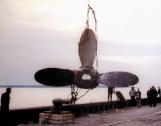1
Team of divers who discovered the wreckageSummer 1964
Pointe-au-Père dock
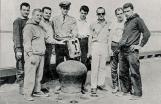 Credits:
Credits:Site historique maritime de la Pointe-au-Père
2
On the tragedy's 50th anniversary in May 1964, an article appearing in the magazine Perspectives (published by La Presse) drew the attention of a group of divers from Gatineau and Montréal. The following July 10, Jean-Paul Fournier, Fernand Bergeron, Claude Villeneuve, André Ménard and Robert Villeneuve headed to Rimouski in hopes of discovering and exploring the wreck of the Empress of Ireland. On their arrival, they set up their tents and their launch close to the Pointe-au-Père lighthouse.The next day, the divers met Aubert Brillant, a wealthy businessman from Rimouski. Taken with their enthusiasm, Brillant decided to come to their aid by making available to them his pleasure boat, La Canadienne, with captain Mario Lavoie and seaman Gaston Fillion on board. In exchange, the divers agreed to deliver half of the objects found, or half of their worth, to Mr. Brillant.
However, because they did not know the exact location of the wreck, the first dives were fruitless.
On July 17, 1964, after a week of trial and error, the wreck was located. At 3:15 p.m., the grappling hook dragged from the stern of La Canadienne caught on an object. The divers immediately entered the water and came up with the first item from the wreck: a pulley.
That summer, a plaque inscribed "First Class Passengers Only," the bell of the navigation bridge, a magnetic compass, a chadburn-telegraph and pieces of dishware were recovered. The 1964 expedition ended on August 17.
3
Yacht La Canadienne used during the first dives to the wreckSummer 1964
St. Lawrence River
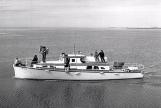 Credits:
Credits:Site historique maritime de la Pointe-au-Père
4
Extract from the ship's logSaturday, July 11, 1964:
At Rimouski last night, we went to Mr. Lavoie's house to get some information on the boat. The captain was kind enough to give us all the information he could remember. He showed us some data on the map.
We then went to Pointe-au-Père for more information. We pitched tents close to the lighthouse. The location is not very good because we didn't sleep well. There was a lot of fog last night.
Wednesday, July 15, 1964:
At 2:00, a bit discouraged, we went to see Mr. Donald Tremblay, who is a professor at the Institut de marine in Rimouski and who has valuable documents on the 1914 investigation in Ottawa. He also has other data in the book and the necessary instruments, which belong to Captain Ouellette, another professor. We needed a sextant and an instrument for measuring the speed of our boat to be able to find the exact location. But out in the open water, there was too much fog and we had to go back to the dock. Anyway, we are hopeful because we have confidence in Donald. We feel like millionaires - the captain grants our every wish. We left to sleep at the hotel and slept very well.
Friday, July 17, 1964:
At 9:30, we were all ready after spending a fairly eventful night and we were not in very good shape; but with all the preparations things looked better. For this afternoon, we had a grappling hook and a 75-lb anchor that we dragged while going around the buoy. At 3:15 in the afternoon the anchor caught on an object that we thought was metal. Claude, André and I went down, and then I brought up part of a tackle. We were certain that we had found the Empress of Ireland. The depth at this location is 140 feet, while on the after deck the depth was 110 feet and the vision 10 feet. We were all a bit nervous. With great difficulty, Claude and I managed to pull up this tackle which must weigh at least 75 lb. The boat is resting on a bottom of sand and hard ice, at a 45 degree angle on its side and with the head toward the open water. Everything went well.
Tuesday, August 4, 1964 :
At 5:00 the four of us down again. But Claude seemed to be nervous, because there was a large whale in the area and some dolphins. He went down to the bottom and came up again immediately because there was water in his mask. But he came back and helped me attach the cable after the telegraph and then he gave me the signal and I started to cut the chains holding the reel, we had some trouble because we had borrowed a large pair of grippers. A pair of grippers that weighed about 75 lb.
Since there was still time, I looked for Ménard, who was still looking for his treasure but didn't find anything. I think that when he reached this depth he lost half his faculties, I signalled to him to come help me because I had the pair of grippers, the light and about a hundred feet of thick cable, but he didn't understand anything. Anyway, I managed to get back up with great difficulty. The dive took 23 minutes, and I was satisfied when I got back up.
Sunday, August 9,1964:
After a rather eventful night, the next morning at 8:30 we were ready and got to the deck of the boat to go back out. The sea was rough, the wind was blowing at 75 miles per hour and the tide was 15 feet.
We had Mr. Brillant with us. When we reached the scene, we had a lot of trouble seeing our buoy, because the current must have been 6-7 knots per hour. It was murder getting down but we managed just the same. I saw Claude clutching the bell that Fernand had found yesterday. He was able to remove the nut without too much trouble.
I attached a porthole but we lost it on the way up. André and I were looking when I signalled that our time was up and Claude came to see me and signalled that there was no more air, so I pulled his reserve. We went up very slowly and we had a terrible time getting onto the boat, what with the wind and the current that had broken our platform. We had to go up on the engines. I was exhausted but once on board they cleaned the bell and we saw inscribed on it "Empress of Ireland" and many other things. We were very happy, and so was Mr. Brillant. We have a lot to do tomorrow.
Thursday, August 13, 1964:
We went straight to the wheel and Claude and I attached the big compass with our small cable and I pulled again and again. But nothing moved and I signalled to Claude, who stayed, that I would go up because I only had small cylinders. Back on the surface, I told them to pull because we had attached the big compass. André Ménard joined Claude but he did not help him. Claude wanted to lift the compass and slip it through the banister, but André insisted on pushing it to the opposite side. Claude finally won. On the boat, they were pulling on the cable. We succeeded in pulling the compass, which weighed at least 500 lb. because it was covered with mud. The end of a successful day.
Monday, August 17, 1964 :
André and I dove to disconnect the line on the lowest side of the boat but it was caught in one of the banisters and in a metal frame. I had to cut it with a knife because I could not get it out. André had gone back up and he joined me again right at the end. We attached the light to the ring and from there we were in "swell house." From the chassis I saw the binoculars, I wanted to approach them but I troubled the water. I went to look in the pilot's cabin but the water was still cloudy, so I had to give up because I couldn't see anything with my little light and the water was very cold. We went back up very tired, the current was 6 knots per hour. We had to hold on very tight to the cable.
5
Decompression bell used during the expeditionSummer 1965
Rimouski, Lower St. Lawrence
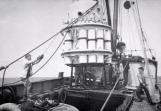 Credits:
Credits:Site historique maritime de la Pointe-au-Père
6
For a second year, Aubert Brillant financed another expedition and worked on the production of a film about the dives. In order to facilitate the divers' task and make their work safer, he had a decompression bell sent from Italy.Two other divers, Harold Smyth and Harry Bell, joined the 1964 team. The objective was to bring up the spare anchor attached on the ship's foredeck. This was extremely difficult work. The connectors had to be dynamited in order to free this steel mass weighing more than 10 tons. A few weeks later, the bow and stern fog bells, weighing more than 200 kg each, were also recovered.
7
The liner's fog bellSummer 1965
Rimouski dock
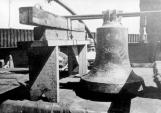 Credits:
Credits:Site historique maritime de la Pointe-au-Père
8
Spare anchor of the Empress of IrelandSummer 1965
Rimouski dock
 Credits:
Credits:Site historique maritime de la Pointe-au-Père
9
(Letter from a 1914 diver)Dear Mr. Brillant:
A friend of mine has just sent me a newspaper clipping which mentions that you are looking for the silver bars and safe of the Empress of Ireland, which sank in 1914. Because I am the sole surviving diver from this expedition, I thought you might be interested to know what we recovered.
We drilled and blasted a hole in the side, then made a path to the location where the silver bars and the mail were stored. We salvaged the 251 silver ingots and the mail pouches. After having done this, we pushed on and took out the boat's safe in a three-stage process. All of these items were transported to Montréal.
We also recovered about 250-300 bodies, most of them passengers, and the front or third class passengers were imprisoned by portholes that were too small. Their heads were emerging from the portholes on the entire length of the boat. You can verify this if you go down. It was an unforgettable sight.
Best of luck, sincerely,
E.J. Tuck
10
The Morrisburg transporting a propeller from the Empress of IrelandSummer 1968
St. Lawrence River
 Credits:
Credits:Donald Tremblay
11
In the summer of 1967, Donald Tremblay and Brian Erb undertook their own recovery work. Their goal was to retrieve one of the two propellers of the Empress of Ireland. They made their attempt on board a 27-metre ship, the Morrisburg.On September 28, 1968, after two summers of work, they succeeded in pulling the portside propeller from the wreck. But because of the propeller's weight (20 tons) and size (6.3 metres), it could not be hoisted on board. It was transported partially submerged.
13
Returning to the Rimouski dock, the team of divers realized that the propeller had lost one of its four blades during the voyage. Not able to find a buyer, the divers sold it to a scrap metal seller for $5,000.The Empress of Ireland had two propellers. Each had four blades attached around a hub in which pins were screwed. The propellers were attached to these pins using seven nuts (four on one side and three on the other). The two propellers thus had a total of 56 nuts.
The diameter of the propellers was 6.3 metres and they weighed 20 tons each. In 1906, they were among the largest propellers. In order to move the liner at the maximum speed of 20 knots (36 km/hour), they turned at a rate of 81 revolutions per minute. Turning both propellers in the same direction would change the direction of the ship. To counter this effect, they turned in opposite directions.
The blades of the propellers were attached with nuts because in 1905, the technique of casting such large propellers as a single piece had not yet been mastered.
